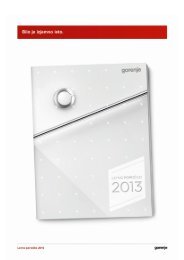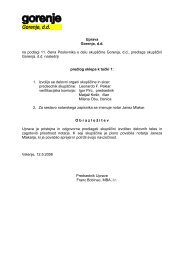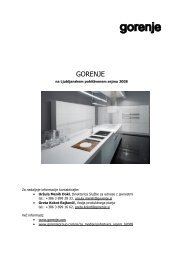Annual Report Gorenje Group 2009
Annual Report Gorenje Group 2009
Annual Report Gorenje Group 2009
You also want an ePaper? Increase the reach of your titles
YUMPU automatically turns print PDFs into web optimized ePapers that Google loves.
A contingent liability of the acquiree is assumed in a business combination only if such a liability<br />
represents a present obligation and arises from a past event, and its fair value can be measured<br />
reliably.<br />
The <strong>Group</strong> measures any non-controlling interest at its proportionate interest in the identifiable net<br />
assets of the acquiree.<br />
Transaction costs that the <strong>Group</strong> incurs in connection with a business combination, such as finder’s<br />
fees, legal fees, due diligence fees, and other professional and consulting fees are expensed as<br />
incurred.<br />
(iii) Accounting for acquisitions of non-controlling interests<br />
The <strong>Group</strong> has adopted early IFRS 3 Business Combinations (2008) and IAS 27 Consolidated and<br />
Separate Financial Statements (2008) for acquisitions of non-controlling interests occurring in the<br />
financial year starting 1 January <strong>2009</strong>. Under the new accounting policy, acquisitions of non-controlling<br />
interests are accounted for as transactions with equity holders in their capacity as equity holders and<br />
therefore no goodwill is recognised as a result of such transactions. Previously, goodwill was<br />
recognised arising on the acquisition of a non-controlling interest in a subsidiary; and that represented<br />
the excess of the cost of the additional investment over the carrying amount of the interest in the net<br />
assets acquired at the date of exchange. The change in accounting policy was applied prospectively<br />
and had no material impact on earnings per share.<br />
(iv) Accounting for borrowing costs<br />
In respect of borrowing costs relating to qualifying assets for which the commencement date for<br />
capitalisation is on or after 1 January <strong>2009</strong>, the <strong>Group</strong> capitalises borrowing costs directly attributable<br />
to the acquisition, construction or production of a qualifying asset as part of the cost of that asset.<br />
Previously the <strong>Group</strong> immediately recognised all borrowing costs as an expense. This change in<br />
accounting policy was due to the adoption of IAS 23 Borrowing Costs (2007) in accordance with the<br />
transitional provisions of such standard; comparative figures have not been restated. The change in<br />
accounting policy had no material impact on earnings per share. The <strong>Group</strong> has capitalised borrowing<br />
costs with respect to property, plant and equipment under construction (see note 3(d)(i)) and<br />
development costs (see note 3(e)(ii)).<br />
(v) Determination and presentation of operating segments<br />
As of 1 January <strong>2009</strong> the <strong>Group</strong> determines and presents operating segments based on the<br />
information that internally is provided to the CEO, who is the <strong>Group</strong>’s chief operating decision maker.<br />
This change in accounting policy is due to the adoption of IFRS 8 Operating Segments. Previously<br />
operating segments were determined and presented in accordance with IAS 14 Segment <strong>Report</strong>ing.<br />
The new accounting policy in respect of segment operating disclosures is presented as follows.<br />
Comparative segment information has been re-presented in conformity with the transitional<br />
requirements of such standard. Since the change in accounting policy only impacts presentation and<br />
disclosure aspects, there is no impact on earnings per share.<br />
An operating segment is a component of the <strong>Group</strong> that engages in business activities from which it<br />
may earn revenues and incur expenses, including revenues and expenses that relate to transactions<br />
with any of the <strong>Group</strong>’s other components. An operating segment’s operating results are reviewed<br />
regularly by the CEO to make decisions about resources to be allocated to the segment and assess its<br />
performance, and for which discrete financial information is available. Segment results that are<br />
reported to the CEO include items directly attributable to a segment as well as those that can be<br />
allocated on a reasonable basis. Segment capital expenditure is the total cost incurred during the<br />
period to acquire property, plant and equipment, and intangible assets other than goodwill.<br />
98<br />
<strong>Annual</strong> <strong>Report</strong> <strong>Gorenje</strong> <strong>Group</strong> <strong>2009</strong>

















